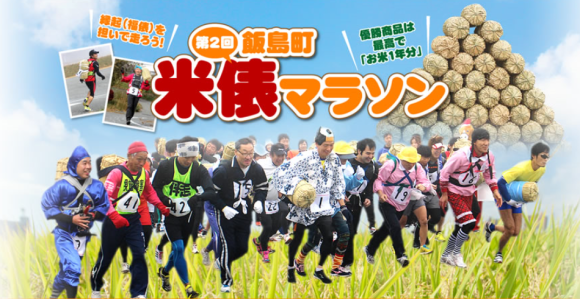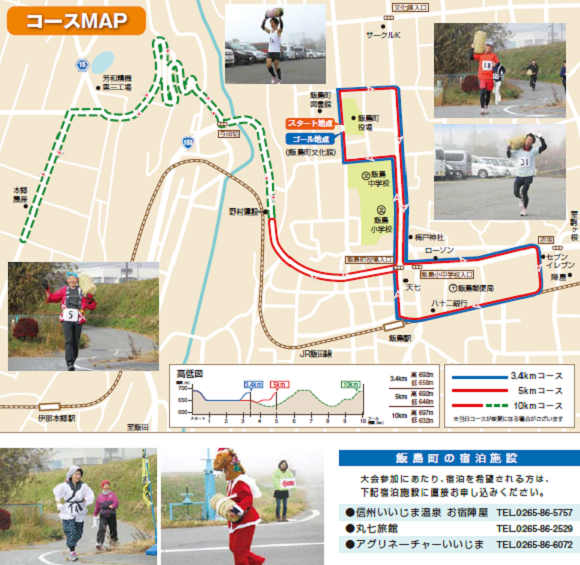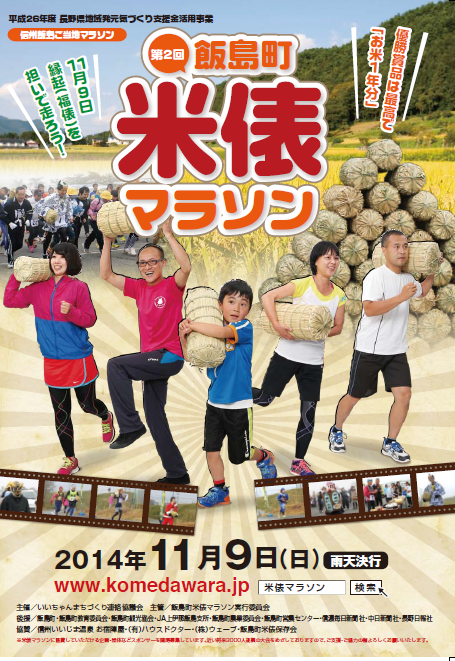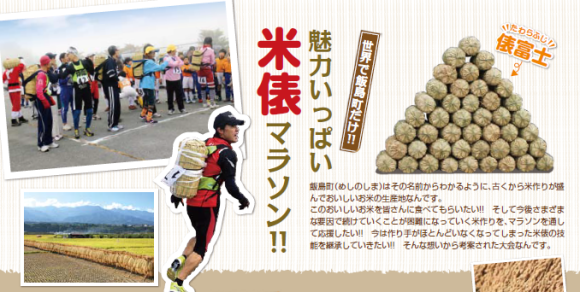
Food always seems to taste better right after getting in some exercise. Unfortunately, sometimes a long workout leaves you feeling starving and exhausted, which is a problem when you then have to go foraging for food after you leave the gym.
While I still haven’t found a gym that’ll reward you with a protein-packed steak for breaking your bench press max, or a pool that’ll hook you up with some sashimi after 1,000 meters of backstroke, there actually is a town in Japan that’ll give you a sack of rice for completing a 5K run. The only catch is, you’ve got to carry it with you during the race.
Tiny Ijimamachi is a city of less than 10,000 people in mountainous Nagano Prefecture. Like in many parts of rural Japan, agriculture is an important local industry, so much so that it’s even connected to Ijimamachi’s name, which means “rice island town.”
On November 9, Ijimamachi will be holding its second annual Komedawara Marathon. While the festivities don’t include a full marathon (Japan likes to use the term “marathon” for any long distance cross-country run), there are three courses for participants to choose from.
▼ Blue: 3.4-kilomter (2.1-mile) course
Red: 5-kilometer (3.1) course
Red/green: 10-kilometer (6.2) course
The shortest run isn’t particularly unique, but the five and ten-kilometer races add a unique wrinkle: Runners carry a komedawara, or straw sac of rice, with them. Adult runners are given a five-kilogram (11-pound) bag, while those under 18 can choose between two and three-kilo (4.4- and 6.6-pound) komedawara.
Those sacks aren’t just a burden, though, but also an incentive to keep putting one foot in front of the other. The fastest runner for each course will receive a year’s worth of rice, and regardless of time, everyone who lugs the komedawara to the finish line gets to take that much rice home with them.
Despite the cheery atmosphere and cosplaying runners (a staple of cross country runs in Japan), participants from last year say the Komedawara Marathon is no joke. A five-kilo sack of rice might not feel too heavy as you lift it from the grocery store shelf into your cart, or carry it up the stairs to your apartment, but it’s a different story when you’re running with it for an hour or more. To make things easier on themselves and let them swing their arms more freely, many runners choose to strap the komedawara to their backs with a harness, rather than carry it in their hands.
If you’d like to run for your meal, the race is set to start at 10:25 a.m., rain or shine, on November 9. Registration opens August 1, with details available on the Komedawara Marathon website.
Related: Komedawara Marathon website
Sources: Japaaan, Komedawara Marathon
Images: Komedawara Marathon




 Sapporo Marathon moves online, becomes way more chill about it all
Sapporo Marathon moves online, becomes way more chill about it all Athletic otaku runs marathon in impressive time while cosplaying as anime magical girl 【Photos】
Athletic otaku runs marathon in impressive time while cosplaying as anime magical girl 【Photos】 Japanese marathoners attacked by swarm of hornets, 115 stung
Japanese marathoners attacked by swarm of hornets, 115 stung Tear up the stage and the 2020 Tokyo Marathon with kabuki-inspired ASICS sneakers
Tear up the stage and the 2020 Tokyo Marathon with kabuki-inspired ASICS sneakers Nara deer stampede into marathon, hit runner in their path
Nara deer stampede into marathon, hit runner in their path Beautiful Red and Blue Star luxury trains set to be Japan’s new Hokkaido travel stars
Beautiful Red and Blue Star luxury trains set to be Japan’s new Hokkaido travel stars Red light district sushi restaurant in Tokyo shows us just how wrong we were about it
Red light district sushi restaurant in Tokyo shows us just how wrong we were about it Tokyo Tsukiji fish market site to be redeveloped with 50,000-seat stadium, hotel, shopping center
Tokyo Tsukiji fish market site to be redeveloped with 50,000-seat stadium, hotel, shopping center Historical figures get manga makeovers from artists of Spy x Family, My Hero Academia and more
Historical figures get manga makeovers from artists of Spy x Family, My Hero Academia and more French Fries Bread in Tokyo’s Shibuya becomes a hit on social media
French Fries Bread in Tokyo’s Shibuya becomes a hit on social media Sandwiches fit for a sumo served up in Osaka【Taste Test】
Sandwiches fit for a sumo served up in Osaka【Taste Test】 Japanese ramen restaurants under pressure from new yen banknotes
Japanese ramen restaurants under pressure from new yen banknotes Japan’s massive matcha parfait weighs 6 kilos, contains hidden surprises for anyone who eats it
Japan’s massive matcha parfait weighs 6 kilos, contains hidden surprises for anyone who eats it Pokémon Sleep camping suite and guestrooms coming to Tokyo Hyatt along with giant Snorlax burgers
Pokémon Sleep camping suite and guestrooms coming to Tokyo Hyatt along with giant Snorlax burgers Limited-edition Carbonara Udon will anger noodle purists and pasta lovers 【Taste test】
Limited-edition Carbonara Udon will anger noodle purists and pasta lovers 【Taste test】 McDonald’s new Happy Meals offer up cute and practical Sanrio lifestyle goods
McDonald’s new Happy Meals offer up cute and practical Sanrio lifestyle goods All-you-can-drink Starbucks and amazing views part of Tokyo’s new 170 meter-high sky lounge
All-you-can-drink Starbucks and amazing views part of Tokyo’s new 170 meter-high sky lounge Studio Ghibli releases new action figures featuring Nausicaä of the Valley of the Wind characters
Studio Ghibli releases new action figures featuring Nausicaä of the Valley of the Wind characters New private rooms on Tokaido Shinkansen change the way we travel from Tokyo to Kyoto
New private rooms on Tokaido Shinkansen change the way we travel from Tokyo to Kyoto Studio Ghibli glasses cases let anime characters keep an eye on your spectacles
Studio Ghibli glasses cases let anime characters keep an eye on your spectacles Beautiful Ghibli sealing wax kits let you create accessories and elegant letter decorations【Pics】
Beautiful Ghibli sealing wax kits let you create accessories and elegant letter decorations【Pics】 Studio Ghibli releases Kiki’s Delivery Service chocolate cake pouches in Japan
Studio Ghibli releases Kiki’s Delivery Service chocolate cake pouches in Japan New definition of “Japanese whiskey” goes into effect to prevent fakes from fooling overseas buyers
New definition of “Japanese whiskey” goes into effect to prevent fakes from fooling overseas buyers Our Japanese reporter visits Costco in the U.S., finds super American and very Japanese things
Our Japanese reporter visits Costco in the U.S., finds super American and very Japanese things Studio Ghibli unveils Mother’s Day gift set that captures the love in My Neighbour Totoro
Studio Ghibli unveils Mother’s Day gift set that captures the love in My Neighbour Totoro New Japanese KitKat flavour stars Sanrio characters, including Hello Kitty
New Japanese KitKat flavour stars Sanrio characters, including Hello Kitty More foreign tourists than ever before in history visited Japan last month
More foreign tourists than ever before in history visited Japan last month New Pokémon cakes let you eat your way through Pikachu and all the Eevee evolutions
New Pokémon cakes let you eat your way through Pikachu and all the Eevee evolutions Sales of Japan’s most convenient train ticket/shopping payment cards suspended indefinitely
Sales of Japan’s most convenient train ticket/shopping payment cards suspended indefinitely Sold-out Studio Ghibli desktop humidifiers are back so Totoro can help you through the dry season
Sold-out Studio Ghibli desktop humidifiers are back so Totoro can help you through the dry season Japanese government to make first change to romanization spelling rules since the 1950s
Japanese government to make first change to romanization spelling rules since the 1950s Ghibli founders Toshio Suzuki and Hayao Miyazaki contribute to Japanese whisky Totoro label design
Ghibli founders Toshio Suzuki and Hayao Miyazaki contribute to Japanese whisky Totoro label design Doraemon found buried at sea as scene from 1993 anime becomes real life【Photos】
Doraemon found buried at sea as scene from 1993 anime becomes real life【Photos】 Tokyo’s most famous Starbucks is closed
Tokyo’s most famous Starbucks is closed One Piece characters’ nationalities revealed, but fans have mixed opinions
One Piece characters’ nationalities revealed, but fans have mixed opinions We asked a Uniqlo employee what four things we should buy and their suggestions didn’t disappoint
We asked a Uniqlo employee what four things we should buy and their suggestions didn’t disappoint Princesses, fruits, and blacksmiths: Study reveals the 30 most unusual family names in Japan
Princesses, fruits, and blacksmiths: Study reveals the 30 most unusual family names in Japan Party game Nippon Marathon promises a hilariously good time racing characters in wacky costumes
Party game Nippon Marathon promises a hilariously good time racing characters in wacky costumes Rice, rice baby! Strains of Japanese rice get turned into cute anime girls on new packaging
Rice, rice baby! Strains of Japanese rice get turned into cute anime girls on new packaging The new “Snow Turtle” train is slower than running, but at least you won’t get tired
The new “Snow Turtle” train is slower than running, but at least you won’t get tired Crazy new port-o-potty design is the most random thing we’ve seen in a long time
Crazy new port-o-potty design is the most random thing we’ve seen in a long time Asics Ukiyo-e x Manga sneakers combine modern and traditional Japan for Tokyo Marathon 2021
Asics Ukiyo-e x Manga sneakers combine modern and traditional Japan for Tokyo Marathon 2021 Mystery of flesh-melting road in Kawasaki solved
Mystery of flesh-melting road in Kawasaki solved Spectacular video footage from inside North Korea by travel vlogger【Video】
Spectacular video footage from inside North Korea by travel vlogger【Video】 You’re under arrest! Mongolian beauty serves and protects【Photos】
You’re under arrest! Mongolian beauty serves and protects【Photos】 Dole establishes Gokusen Day with 59 of their absolute finest serial numbered bananas
Dole establishes Gokusen Day with 59 of their absolute finest serial numbered bananas Does running like Naruto really make you faster? A YouTube science channel investigates【Video】
Does running like Naruto really make you faster? A YouTube science channel investigates【Video】 Friezas continue their yearly tradition of cheering on runners in Japan’s New Year’s relay race
Friezas continue their yearly tradition of cheering on runners in Japan’s New Year’s relay race Japan’s first Dinosaur Race features T. rexes flopping their way across the finish line 【Video】
Japan’s first Dinosaur Race features T. rexes flopping their way across the finish line 【Video】 Dole Japan awarding personalised Banana Trophies to 200 runners in this year’s Tokyo Marathon
Dole Japan awarding personalised Banana Trophies to 200 runners in this year’s Tokyo Marathon Japanese men reveal their favorite women’s lingerie colors in survey
Japanese men reveal their favorite women’s lingerie colors in survey Kumamoto mascot Kumamon’s chance of being Olympic torch runner in jeopardy
Kumamoto mascot Kumamon’s chance of being Olympic torch runner in jeopardy Simple wrist test shows whether your body type is that of a model, athlete, or sumo wrestler
Simple wrist test shows whether your body type is that of a model, athlete, or sumo wrestler
Leave a Reply